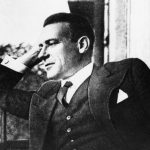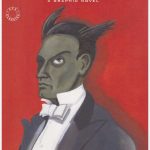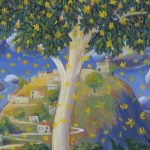Exploring the Representation of History in `One Hundred Years of Solitude` and `The Master and Margarita`
The Late Modern Era was a period of monumental transition, with technological, cultural and political revolutions serving to rapidly change the world`s landscape. Many of the era`s influential authors sought to capture this significant historical period through their fiction, whilst also exploring the philosophical nature of human history. Two such authors, the Colombian Gabriel Garcia Marquez and Russian Mikhail Bulgakov, did this to great critical acclaim in their magnum opera `One Hundred Years of Solitude` and `The Master and Margarita`, novels published in the same year (1967), though under very different circumstances. The former chronicles the history of the fictional town of Macondo, whilst the latter describes the visit that the devil and his retinue pay to Stalinist Moscow. In this essay I shall explore the techniques Marquez and Bulgakov employ in order to represent the politics, culture and society of the historical periods of their time, with contextual reference throughout, as well as analysing the wider implications of their portrayal of history.
Initially, one may not expect these works to reflect historical truths, due to the fantastical elements present throughout their narrative. Marquez was one of the central figures behind magical realism, the literary style where the fantastical is described in a mundane manner. This style is evident in `One Hundred Years of Solitude` in the passage where Remedios the Beauty ascends into heaven along with her clothing sheets, with Marquez choosing to place greater emphasis upon “the flapping sheets” that “were lost forever”. While one may consider such a stylistic choice to be incongruous, it is through this technique that Marquez infers that such fantasy deviates little from the absurdity of Colombian political history.
Chapter fifteen describes the massacre of the three-thousand revolting plantation workers at the hand of the conservative government, an event that only Jose Arcadio Segundo survives after feigning death. Though afterwards, the very objectivity of this reality comes into question, for “People did not believe [Arcadio`s] version of the massacre or the nightmare trip of the train loaded with corpses travelling toward the sea either…The official version…was finally accepted: there were no dead”. There is great irony in the use of the word “nightmare”, for it infers that Macondo`s incredulity was due to its populace, one used to and indifferent to absurd events such as Remedios` ascension into heaven, not being able to comprehend the brutality of such an act despite the evidence. Moreover, Marquez describes how the government “finally” manage to persuade Macondo`s public that the massacre never occurred, therefore changing their view of history. This is a scathing reference to the period of `Conservative Hegemony` in Colombia, where the conservative government worked alongside American capitalists such as the owners of the real United Fruit Company. On December 6, 1928, around two-thousand protesters who worked for the company in the town of Ciénaga were killed, and the massacre was subsequently covered up.
This brutality and corroboration with capitalism is foreshadowed in the twelfth chapter where Colonel Aureliano Buendia, a famous liberal fighter, shows signs of rebellion towards the Americanisation of Macondo and as a result “his seventeen sons were hunted down like rabbits by invisible criminals”. The simile relating to the “rabbits”, alongside the sibilance in the repetition of the `s`, sound reinforces the helplessness of the victims and the malevolence of the government. Whilst the fact that the murderers are described as “invisible criminals” adds to the idea of the scheming nature of the government, for again they act deceitfully, “promising” the Colonel “an extensive investigation” into the murders.
This representation has roots in Marquez`s own personal background as his grandfather, Colonel Nicolás Márquez Mejía, was a famous Liberal who fought against the Conservatives and similar to Jose Arcadio Segundo, refused to remain silent about his knowledge of the banana plantation massacre. It can therefore be inferred that Marquez sought to preserve the truth about the evils of `Conservative hegemony`, which is supported by his description of Mejia as his “umbilical cord with history and reality” (2).
Correspondingly, through the fantastical style employed throughout `The Master and Margarita`, Bulgakov sought to invert the genre of socialist realism`, which dominated Russian literature throughout the entirety of Communist rule. Socialist realism was a teleologically-oriented style used as propaganda to support Communist ideology and practice, with scarce use of fantastical imagery or ideas. Therefore the novel was in direct opposition to this style and Communism, for not only did it feature fantastical characters and occurrences, but these fantastic elements also had the purpose of satirizing and criticizing the absurd nature of the political system that Stalin had created in Russia after his succession to power in 1922. This relates to Bulgakov`s ideological beliefs for he fought for the White Movement during the Russian Civil war, and is often cited as being a Monarchist (3).
In the novel Woland, the Devil, alongside his henchmen: Koroviev, Behemoth, Azazello and Helga, create chaos in Moscow, with their actions leading to “four gutted buildings and hundreds of people driven out of their minds” as well as “several people ha[ving] been killed”. These doings refer to Stalin`s brutal regime, with around tens of millions of deaths attributed to it and there is great irony in the novel in the fact that the actions of the Devil, a figure that epitomises evil, compares in no way to that of Stalin. This disparity between the evil doings of the devil and Stalin`s administration is highlighted through black humour in the epilogue, where seemingly “Cultured” citizens and police of Moscow turn to accusing black cats of the crimes of the evil spirit behemoth who took the form of such an animal: “A good hundred of these peaceful, devoted and useful animals were shot or otherwise destroyed in various parts of the country”. This passage reinforces the lack of distinction between the real and fantastical, with Bulgakov reflecting upon the absurdity of an administration that needs little evidence to begin massacring and implicating its own people, of whom the vast majority were “peaceful, devoted and useful” towards the Communist cause.
The fantasy present in both works frequently has religious significance and through such allusion the authors reinforce their representation of the culture of their countries. Firstly, since European Colonialism in the sixteenth century, the vast majority of people in Colombia and Latin America have been Catholic. Though historically the continent has always been tied to its `pagan` roots. After the banana plantation massacre, Marquez describes in the detached style of Magical Realism how “It rained for four years, eleven months and two days”. As a result, all of the new American inhabitants who arrived after the introduction of the railway system evacuate the town. In doing so they leave behind Macondo`s original inhabitants who “seemed happy to have recovered the town in which they were born”. The fact that it is inferred that divine intervention restores the original culture of Macondo not only represents Marquez`s anti-imperialist views during the twentieth century where America meddled in Latin affairs to such an extent that the area was nicknamed “America`s backyard”, but also the historical disparity between the superstition nature of his culture and the logical, materialist American belief system. This notion also relates to Marquez`s distinctive style as in part it took shape in conscious opposition to the Colombian literary status quo”(4) who he saw as unrepresentative of the continents culture and history in order to fit western expectations.
Bulgakov also explores religious ideas in order to reflect upon Soviet culture. He despised Russia`s newfound bureaucracy in the 1920s (after a period of almost a thousand years of it holding Orthodox Christian beliefs) in its aggressive advocation of atheist propaganda. When Bulgakov`s diaries were unearthed after his death he wrote of Efim Alexandrovich Pridvorov (1883-1945), a strongly atheist writer: “He presents Jesus Christ’s as a cheat and a swindler… there are no words for such crime”(5). Such dislike of the dogmatic atheism of the time is satirically represented in the novel by the character of Bezdomny who, similar Pridvorov, is commissioned by the Muscovite literary organisation `MASSOLIT` to write a poem disparaging Jesus, yet in turn he is disparaged by the union for through his portrayal he ironically manages to create a Jesus that is “completely alive”. The historical objectivity of the character of Jesus is further present in the frame story of Yeshua Ha-Nostri (representing Jesus) and Pontius Pilate. In the story, Yeshua is portrayed as enlightened human as opposed to a divine figure, evident in the human qualities that he displays when he pleads to Pilate`s centurion “don`t beat me” as well as when he speaks “shamefacedly” about his homelessness. Through this alternative depiction of Jesus, Bulgakov reinforces the idea that a revisionist approach can be taken to the Bible, with there being more to the understanding of the divine than just denouncing it like Bezdomny with “complete ignorance of the subject”. What is more, Bulgakov shows that the stifling nature of Soviet bureaucracy upon Russian culture extended even further than religious expression. Bulgakov uses the character of the Master in his novel to directly oppose the Communist censorship of literature, which affected his life and work greatly. In the novel the Master`s book about the story of Pontius Pilate receives heavy criticism from the figure of Latunsky, who is inferred to have connections to MASSOLIT and therefore Stalin`s administration. This leads to the Master falling into despair and isolating himself from society, just like Bulgakov who`s less orthodox works were not only criticized by Russia`s literary `elite`, but censored by the Communist Party and even Stalin personally.
By 1929, Bulgakov could not publish any of his plays or novels and was not allowed to leave the country. The most evident sign of rebellion towards censorship passages in the novel comes Woland returns the previously burned manuscript of the Master`s Pontius Pilate novel, telling him that “manuscripts don’t burn”. This provides a positive message that such repressed the works and culture will eventually resurface, like Bulgakov`s novel twenty-seven years after his death. This is supported by the fact that Bulgakov knew that his works could never be published during his life, yet still chose to “struggle against censorship” which he saw as his “duty as a writer”(7). Marquez`s and Bulgakov`s struggle against the status quo also takes the form of their representation of the impact ideology had on their societies. Marquez`s held strong left-leaning political views, which was evident in his friendship with Fidel Castro(6). However, in his novel Marquez serves to criticize the very nature of such beliefs present in Colombian 4 society. This notion is reinforced in the passage where the staunchly liberal Colonel Aureliano Buendia in his old age, learns the truth about the fact that he is “fighting because of pride”, whilst the liberal party is fighting for “power”, and that his friend Colonel Gerineldo Marquez, is fighting for an ideology that “doesn’t have any meaning”.
This sudden realization reflects upon Marquez`s and in turn Colombia`s disenfranchisement with the persistent ideologies of Liberalism and Conservatism that have run throughout Colombian history and lead to tragedies such as the Thousand Years War (1899-1902), represented by the civil war in the novel, which resulted in more than one-hundred causalities which the. Moreover the loss of “meaning” in the ideology of the Colombian people and it solely serving as a tool of division is reflected in the fact that Marquez told Castro that “In Colombia you are either Conservative or Liberal from birth, it doesn’t matter what you think”7. On the other hand, Woland visits Moscow in order to observe the new ‘social experiment’ carried out by Stalin`s administration concerning the impact of Communist upon the Russian populace: “I simply wanted to see the Muscovites en massé”. The Devil later compares the Muscovites to the people of ancient Jerusalem as well as to humanity as a whole. From this comparison, he reaches the conclusion that overall the Muscovites are “reminiscent of the former ones”. Through this passage Bulgakov’s portrays his scepticism towards the Socialist and Soviet belief that through deconstructing Russian society through the removal of class boundaries, the human nature of Russia`s inhabitants could be alterable. However through Woland`s perpetual observation of humanity, Bulgakov is conveying the idea that in even in such a vastly changing world, no fundamental change has occurred in our human nature in people, with every new generation of people exhibiting traits similar to their predecessors.
This repetitive nature of human history serves to an even greater extend form the very theme of `One Hundred Years of Solitude`. This is evident in the similarity in the names of the Buendia`s, particularly in the Male members, with them all either being called a variation of `Arcadio` and `Aureliano` and exhibiting the predominant trait of solitude. As a result, Ursula Iguaran realises that “time was not passing…It was turning in a circle” and attempts to end this repetitive naming. However, due to the inherent tradition of the Buendia`s, further generations are again named Arcadio and Aureliano. This infers that mankind is fated to repeat historical mistakes and this concept is heightened by the fact that at the end of the novel, Marquez shows that the history of Macondo was pre-determined since its conception: “it was foreseen that the city of mirrors (or mirages) would be wiped out”.
Such parallels between Marquez`s and Bulgakov`s representation of history, that have been evident throughout this essay, must initially appear surprising due to the sheer distance between Colombia and Russia. Yet under closer inspection, one can see that these two countries are in fact inherently comparable through the idiosyncrasy that arose in their politics, culture and society as a result of the significant changes that occurred during the Late Modern Era. In their vivid, humorous, dark, fantastical and poignant representation of the struggles faced by their people during such trying times, Marquez and Bulgakov captured the deeper humanity of the period, which could not be achieved through fact alone. It is through this ground-breaking genius that the two figures have embedded themselves and their work into our understanding of not only the Late Modern Era, but of human history itself.
Gallery
References
1. Posada-Carbó, Eduardo: `Fiction as History: The Bananeras and Gabriel Garcia Marquez`s One Hundred Years of Solitude`, 1998 Cambridge University Press.
2. Simons, Marlisle: ` Storyteller With Bent for Revolution: Gabriel Garcia Marquez`, New York Times Article, 1982
3. Haber, Edythe: ` Mikhail Bulgakov: The Early Years`. Harvard University Press; 1st Edition edition (31 July 1998).
4. Bell-Villada, Gene H. (1990), García Márquez: The Man and His Work, North Carolina: University of North Carolina Press,
5. http://www.masterandmargarita.eu/en/03karakters/ivan.html
6. Bulgakov, Mikhail: `Manuscripts Don’t Burn: Mikhail Bulgakov A Life in Letters and Diaries`
7. Martin, Gerald: ` Gabriel Garcia Marquez: A Life`, Vintage: August 31, 2010. Bulgakov, Mikhail: `The Master and Margarita`, Everyman`s Library: 1992. Marquez, Gabriel Garcia: `One Hundred Years of Solitude`, Penguin Modern Classics: 2000.












